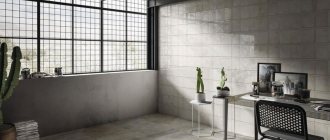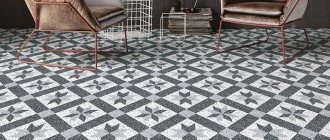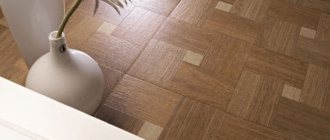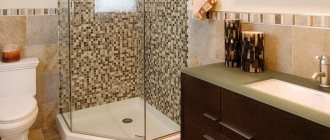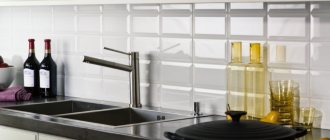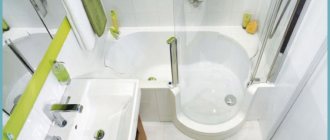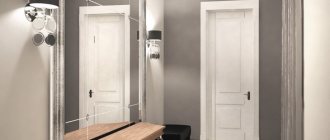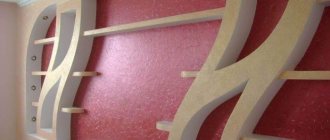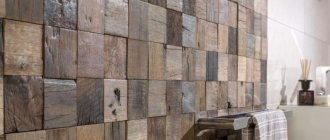Advantages and disadvantages of foam ceiling tiles
The advantages of this material are as follows:
- Since the temperature of radiators or radiators in apartments is no more than 80 degrees, such tiles can be safely installed in close proximity to them;
- Foam ceiling tiles can be glued to any surface;
- Under normal conditions, the service life of foam plastic tiles is calculated in decades, since this material is not afraid of dampness;
- The light weight of this material allows the use of adhesive compositions for gluing, which are not particularly durable and, accordingly, expensive;
- Foam ceiling tiles are very dense, therefore they have excellent sound-proofing and heat-insulating properties;
- Polystyrene foam is an environmentally friendly material;
- Foam panels are very easy to cut, so their installation does not take a lot of time and effort;
Despite all the advantages, foam ceilings have many disadvantages. The cheapest foam tiles are not very durable; over time, they begin to turn yellow from sunlight, and some of them do not tolerate dampness well. However, this disadvantage can be easily corrected, turning it into an advantage, because foam tiles can be painted with ordinary water-based paint.
The most important disadvantage of foam ceilings is their vapor permeability - foam can create a thermos effect in the room, which prevents the walls from absorbing excess moisture. When combining foam plastic, for example, with vinyl wallpaper, the risk of fungus appearing in the room increases significantly.
Types of ceiling tiles
According to the manufacturing method, pressed, extruded and injection options are distinguished. The last two are distinguished by their high cost and a wide range of different qualities. Pressed slabs are made from blocks using compression. Their performance characteristics include many restrictions, so the material is used with an emphasis on pricing. There are also design restrictions for use in various interiors. Extruded versions are produced by pressing strips. The advantages of raw materials are expressed in durability and perfect structure. Extruded tiles are also used to imitate natural materials: their colors and textures. Injection molds are manufactured at high temperatures, which provides additional processing capabilities. The surface layer is clear thanks to special molds for manufacturing.
Pressed
It is obtained by stamping (pressing), which is why it got its name. Pressed tiles are made from a base in the form of polystyrene foam blocks. The press compresses the raw material to a thickness of 6-8 mm. The quality of the products is not the highest, but manufacturers compensate for this with a low price. This is the most affordable option among the main ones offered by the market. The surface has a porous, loose texture, which has a bad effect on performance. Dirt must be wiped off immediately, but washing is not recommended at all. In this case, painting with water-based solutions will not interfere. When choosing, be sure to be guided by the safety margin, because the slabs are relatively fragile and often break. There is also an unpleasant feature in the structure of the edges: when cutting, they sometimes crumble. Before covering the ceiling, the slabs are kept in a dry room for 3 days to avoid shrinkage and the appearance of cracks in the finishing layer.
Extruded
The product is made from polystyrene strip obtained by pressing. The workpiece is painted or laminated. The surface of the material is perfectly smooth and without a grainy texture. The coating has good density, water and dust repellent properties. Thanks to these features, as well as lamination, the slabs can be washed. The finished material turns out to be more expensive than the pressed (stamped) material, but at the same time it is stronger and provides greater reliability and hygiene. The shape of the tile has “memory”: the material quickly recovers after deformation. The products are produced in the form of squares, most often with parameters of 50x50 cm. The edges of the slabs are perfectly even in shape, and the canvas itself is convenient to cut. There is a small cavity on the back side - because the ends are slightly bent down. This feature allows you to hide small defects in the ceiling.
Injection
In production, sintering of polystyrene foam components is used. During the manufacturing process, the correct shape is controlled, and after processing, a clear and deep pattern remains on the finished coating. The method gives a thickness in the range of 9-14 mm, and among all the options for ceiling tiles, injection is the thickest. The ceiling surfaces are ultimately formed without visible seams. Injection finishing has soundproofing properties. Moreover, in addition to noisy rooms, it is also suitable for humid ones, since increased indicators will not spoil the structure. The plates are highly durable and do not burn. They are environmentally friendly. The products are sold in white - this design will be optimal for ceilings, but it wouldn’t hurt to add some creaminess to the shade. The problem with injection products is their high price: stamped options, for example, are 3-4 times cheaper.
Choosing foam ceiling tiles
- Pressed or stamped tiles , the thickness of which is 6-8 mm. It is made from polystyrene foam blocks. The porous surface of this slab absorbs dirt, which is very difficult to wash off; it is easier to paint over it. It is not very practical to use, but it has a low cost.
- Seamless or injection ceiling tiles have the correct dimensions and a clearly defined pattern. The method of sintering raw materials helps to achieve this result. The high density of this type of tile allows you to create seamless ceilings. Disadvantages include the ability to absorb moisture.
- Extruded tiles have the highest price. It is made from pressed polystyrene strip, and then painted and laminated. The smooth, fine-grained surface of the tile allows it to be painted in any desired color if necessary. Extruded ceiling tiles have the highest hygienic properties.
When purchasing tiles for the ceiling, make sure that they are strictly square: even at the edges and straight at the corners. Carefully inspect the edges to ensure they are strong. It is extremely important that the polystyrene grains are the same size - this is an indicator of the strength of the ceiling tiles.
Selection and purchase of ceiling tiles at "Plintus Wholesale"
In the catalog presented on this page you will find high-quality and affordable ceiling tiles of Russian and foreign production. Choose the option that best suits your design and make repairs without extra costs!
Please note: tiles are sold only in packages; the number of tiles per package is indicated in the catalogue.
Do you have questions about how to choose and buy ceiling tiles? Contact our consultants for help by phone or request a call back - specialists will answer you and help you make the right purchase.
Using foam ceiling tiles
Foam ceiling tiles are a universal finishing material because they can be used to decorate almost any room. Most often, ceiling tiles can be seen in the office, living room or bedroom. In these rooms, such tiles look especially advantageous due to their ability to visually increase the height of the ceiling.
Also, no less actively, such tiles are used to decorate the ceiling in the kitchen, but in this case they must have a protective laminated coating. For a children's room, you can choose ceiling tiles with a special layer of sound-absorbing material. For a toilet or bathroom, you can use smooth white ceiling tiles, or slightly corrugated ones.
Required Tools
To glue foam ceiling tiles you will need the following tools:
- laser level;
- stationery knife;
- putty knife;
- scissors;
- miter box;
- swing hand;
- square;
- roulette;
- meter ruler;
- leg-split;
- pencil;
- ladder.
Advantages and disadvantages of use
They are made of polystyrene foam, which foams when exposed to high temperatures. This property helps to obtain a durable, lightweight material that can have different textures and relief patterns.
Advantages:
- Good value for money. Covering the ceiling with polystyrene foam tiles will be much cheaper than making suspended ceilings.
- Safety and environmental friendliness of the material. Only when smoldering does polystyrene foam release harmful fumes, but in its normal state it is completely safe for residents.
- Durability of cladding. If installed correctly, ceiling cladding with polystyrene foam tiles will last for many years.
- They can be painted, which allows you to further decorate the tiles and protect them from moisture or sunlight.
- Easy to install. Polystyrene tiles are easy to cut and installation does not require any special technology. You don't have to be a professional to lay ceiling tiles beautifully.
Flaws
It will not be possible to hide the noticeable flaws of the ceiling.
- From high temperatures, with an incorrectly selected lamp, polystyrene foam will turn yellow and lose its attractive appearance. Choose a lamp of sufficient length so that the cladding does not heat up.
- Expanded polystyrene is a fragile material that breaks easily during transportation or during operation. You need to be careful.
- Temperature changes will cause the tiles to fall off. Choose a good glue to ensure a secure hold.
- If you do not take care of the tiles, stable and difficult to wash off stains will appear. In this case, there is nothing you can do to help the tile: you need to replace the damaged fragments.
Installation work
First of all, you need to immediately cut all the tiles into the required sizes. This can be done with scissors or a stationery knife, the main thing in this is to avoid any errors, since this can play a cruel joke on the evenness of the ceiling. The next step is to disconnect the electrical wiring. Work should be carried out with gloves so as not to stain the ceiling tiles. It is recommended to apply the adhesive pointwise along the perimeter and diagonals (about 25 points per tile).
Before attaching the foam tiles to the ceiling, you should let them sit for about 5 minutes so that the glue reaches the required conditions. You should start from the intersection of the marking lines. The edges of the tiles must clearly coincide with the marking lines. After which you should move forward from the first tile, thereby forming two perpendicular rows, and under no circumstances should you move away from the markings. Then, row by row, you need to glue the remaining rows. Once all the rows are completely glued, you need to attach the decorative border. In order for the corners to fit perfectly, it is best to use a miter box.
Tips for gluing ceiling tiles
So, the preparatory work is completed. Now you can start gluing itself. To work you need liquid nails. They are an adhesive. They are great for renovation work. After the liquid nails harden, the strength of the material is achieved. When applied, they penetrate into the cracks, and as a result excellent adhesion is ensured. When laying tiles using liquid nails, you must carefully follow the instructions.
The tiles need to be laid out in rows from the wall on the window side to the other wall. If there is a chandelier on the ceiling, then it is advisable to start work from the center, having made the necessary calculations first. When gluing, observe the symmetry of the design. Skirting boards are attached near the walls.
Ceiling tiles in the bedroom
Types of tiles
Modern manufacturers present the material on the market in three variations:
- Stamped. The simplest type, in the manufacture of which polystyrene granules are pressed. The material is not of very good quality. But it is the cheapest of all.
Typically, a pattern or ornament is applied to the front side of such a tile. The fragility of this type of tile requires careful handling and accuracy in work.
- Injection. Dense and durable material thanks to a special production method, when polystyrene is cast and sintered in dense molds under high pressure. The correct shape, clearly defined relief are the advantages of this type. It can be painted with any water-based or acrylic paint.
- Extruded is made from extruded foam plastics, has a smooth and shiny surface, sometimes covered with a protective film, or imitating natural materials.
Production of this type is characterized by the complexity of the technological process using high-tech equipment, with simultaneous stages of molding and pressure.
Ceiling decoration with polystyrene tiles: simple, beautiful and cheap
Content:
Ceiling tiles today can be considered one of the most technologically advanced and profitable finishing materials. Its advantages are obvious: the tiles are easy to stick, they are relatively inexpensive and are suitable for decorating the ceiling in any room. The tiles mask well minor defects of the surface being pasted over (unlike ceiling wallpaper or paint, which, on the contrary, make cracks and irregularities more noticeable).
Today, ceiling tiles are made from expanded polystyrene or polyurethane foam. Polyurethane tiles have a number of significant advantages: they are comparable in density to wood, but do not deform over time; In addition, they do not turn yellow or crumble. Polystyrene tiles, having all these qualities, also weigh much less (which means they are easier to install) and are cheaper. Polystyrene tiles are odorless and completely safe.
Modern industry produces two modifications of ceiling tiles: square (50 by 50 centimeters) and rectangular (100 by 16.5 centimeters). The color of the material is usually white, but tiles are also available, treated with laminated film in different colors and patterns, from abstract patterns to imitation of the structure of wood, stone or fabric. Surface lamination, in addition to being decorative, also has a protective function, making the material more resistant to moisture. White (not laminated) tiles can be coated with water-based paints, decorating the ceiling in accordance with the style and design of the room.
Installation of ceiling tiles is extremely simple: they are glued to a previously prepared surface. The ceiling to be pasted must be cleaned of dirt and, if necessary, degreased. A heavily contaminated or very porous surface is covered with a layer of PVA glue diluted with water. The same glue or any of the special adhesives for ceiling coverings is used as a fixing material. Fix the tiles starting from the middle of the ceiling. If a whole tile does not fit near the walls, it is very easy to reduce it by cutting off the extra centimeters with a sharp knife. Caring for such a ceiling is also easy: the laminated surface is simply wiped with a damp cloth, and the non-laminated surface is cleaned dry (most often with a vacuum cleaner with a brush attachment).
How to glue polystyrene foam boards
Material calculation
To avoid unnecessary expenses, you need to first calculate the amount of material. To do this, the room is measured and the number of whole tiles placed along the length and width of the room is calculated. The resulting numbers are multiplied, one square is added to them for each large gap and one square for sealing two small gaps. The resulting number is the number of tiles that will be needed to finish the ceiling surface.
When purchasing material, you should purchase it with a 10% margin.
Glue selection
In addition to purchasing tiles, you need to purchase high-quality glue so that the finishing does not become in vain and the tiles do not fall off the ceiling surface.
The best option would be to use the “Moment – liquid nails” composition. Its thick consistency and ability to quickly harden, coupled with reliable fixation of the material, will significantly reduce the physical and time costs of installing tiles.
Glue such as “Dragon” is also common on the market. However, experts do not recommend purchasing it due to its low adhesive properties.
For a room of 20 square meters, the glue consumption will be approximately 350-400 ml. On sale you can find compositions intended for use with a glue gun. In this case, the material consumption will be more economical, and a 450 ml container will be enough not only to paste the ceiling in the room, but also to install the ceiling plinth.
On uneven ceilings, polystyrene foam ceiling tiles should be mounted with finishing putty. In this case, two actions will be performed simultaneously - leveling the ceiling and finishing it.
You can prepare the adhesive composition yourself. To do this, stir the dry putty mixture in water and add PVA construction glue at the rate of 200 grams of glue per 1 kg of putty.
Tools
Simplicity of installation work does not require special devices. It is enough to prepare a painting cord for applying markings, scissors or a stationery knife to cut the material, a spatula, a tape measure and napkins to remove excess adhesive.
Ceiling preparation
The base surface must be carefully prepared before tiling the ceiling. First of all, the remnants of hanging plaster are removed with a spatula, and cracks and cracks are sealed with a solution. If the finishing thickness of the rough surface is small, it must be covered with a thin layer of putty. But the whitewash must be completely removed, because it prevents reliable adhesion of the material to the ceiling.
To improve the adhesive qualities of the fixing composition, experts recommend treating the ceiling surface with a deep penetration solution. It is prepared as follows:
- 5 liters of water are poured into the container.
- Add to the liquid 1 bar of coarsely grated laundry soap and half a liter of PVA glue.
- The solution is brought to a boil and simmered over low heat for 30 minutes, stirring constantly until the mass becomes a homogeneous consistency.
After the specified cooking time, the composition is allowed to cool and applied to the ceiling with a roller or wide brush.
Installation
There are several ways to glue tiles to the ceiling:
- parallel rows;
- in a checkerboard pattern;
- diagonally.
If a pattern is applied to the squares, it is necessary to take into account its correct placement on the ceilings. In this case, it is recommended to start finishing from the center of the room. To determine it, diagonals are drawn from corner to corner. The place where they intersect will be the starting point for work.
When gluing the ceiling away from the walls, the pattern may shift. Then you will have to hide the gaps in separate pieces, which will not only spoil the overall impression of the repair, but will also cause the generation of a large amount of waste.
The glue is applied to the back of the tile in small dots every 3-5 cm. Then the tile is pressed to the base. The time for complete attachment of the finishing material to the ceiling depends on the quality of the glue. It is recommended to apply some compounds to the tiles and wait a few minutes before applying the square to the ceiling.
Note! If a chandelier is installed on the ceiling, then it is the point of its attachment that should be taken as the center. Otherwise, the symmetry of the room will be broken and the ceiling will look ugly.
When pressing the tile, do not overdo it, otherwise the material will wrinkle. Adhesive stains must be removed immediately with a rag. The next tile fits as tightly as possible with the previous one.
Noticeable joints between the squares are filled with white acrylic sealant. It is not recommended to use silicone, as it may turn yellow over time.
Finishing the ceiling plinth
After the polystyrene foam ceiling tiles are glued to the ceiling, the gaps between the wall and the tiles, as well as the outer ceiling cracks, are masked with slats or baseboards. They also differ in shape, colors and textures.
If the room is small, it is preferable to use narrow planks with small patterns or smooth relief. Massive skirting boards will look harmonious in large rooms.
You can glue the baseboards before gluing the wallpaper or after it is completed. The second option is preferable, since it can be used to correct mistakes made when wallpapering walls.
The same adhesive composition is used for the baseboard as for the ceiling tiles. It is better to cut the corners using a miter box, this will simplify the joining of the material.
Caring for polystyrene foam tiles is not difficult. It is enough to carry out regular vacuuming and wet cleaning.
Tile care
Like any other ceiling surface, polyurethane ceiling tiles need maintenance. At a minimum - periodic wiping from dust and soot.
In addition, it requires some precautions:
- It is better to hang a chandelier with incandescent lamps open at the top at a distance of at least thirty centimeters from the tiles. The reason is possible deformation of polystyrene foam when heated. The material is thermoplastic. If the chandelier has already been selected and hung, simply replace the incandescent lamps with energy-saving ones. They heat up much less.
- To wipe laminated tiles, you can use a damp sponge with detergent or soapy water. It is better to wipe tiles with a grainy surface with a dry cloth. Laminate tiles are easy to clean with a sponge and soapy water.
Laminate tiles are easy to clean with a sponge and soapy water.
- Minor stains can be easily removed with a simple eraser. Of course, you shouldn’t press the eraser too hard: polystyrene can easily be dented.
